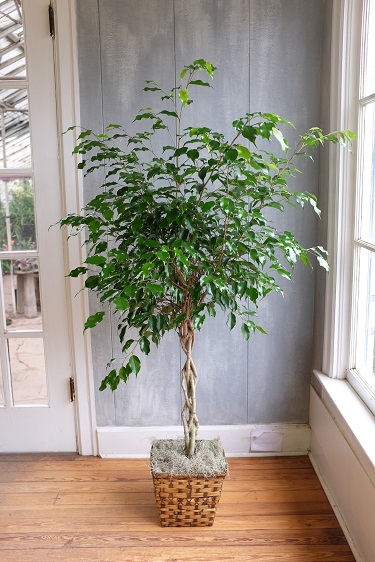
Ficus benjamina is a beautiful plant that is commonly grown indoors as a houseplant. A well-kept Ficus can add dramatic interest to an otherwise plain room, and like other houseplants, it helps clean the indoor air. However, Ficus are notorious for dropping their leaves and generally being difficult to care for. Some insight into their likes and dislikes will help you keep your Ficus benjamina happy.
Ficus benjamina do best in high humidity but they don’t like to have wet feet. The plants may be misted daily, but they should be watered only when the top two inches of their soil feels dry to the touch. The soil should be allowed to dry slightly between watering in the winter. Overwatering will cause Ficus leaves to turn yellow and drop.
Ficus are homebodies; once they are settled into a spot they like, they will protest by dropping leaves if they are moved to another location. They prefer bright, filtered light and a consistent air temperature so keep your Ficus away from drafty outside doors, large windows that change temperature throughout the day, and heater vents. Avoid locations that receive direct sun all day.
During the growing season, your Ficus should be fertilized monthly with a slow-release fertilizer or half-strength liquid fertilizer. Do not fertilize a Ficus during the winter when it is not actively growing.
Ficus benjamina doesn’t mind being a bit root bound, but if they become too crowded in their pot, new leaves will be small, and the plant will grow slowly. They can be repotted in late winter or early spring, when they’re as close to dormant as they’ll get. Use a well draining potting soil in a slightly larger pot when repotting them.
If your Ficus begins to drop leaves, check the soil moisture. Decrease watering if necessary and give it some mist daily but don’t fertilize the plant. If it’s getting too much or not enough light, move it to a better area. Then be patient because it can take several weeks for the plant to adjust and stop dropping leaves.
Mike McGroarty is the owner of McGroarty Enterprises and the author of several books. You can visit his website at FreePlants.com and read his blog at MikeBackYardNursery.com.
Related Articles & Free Email Newsletter
Plant Profile – Dracaenas Require Little Effort and Remove Harmful Toxins
Plant Profile – Plumerias Are A Beautiful and Fragrant Tree


Comment here